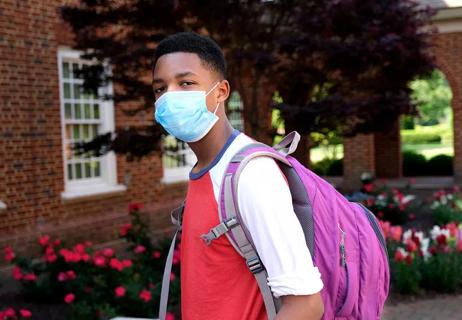Asthma-proof your home, keep notes and (try to) be patient with long-term treatments

Your child is all set for soccer practice when their asthma flares. Or maybe they’re snuggled in their bed when they wake up suddenly and reach for their rescue medication. Whether it happens during play or at rest, it’s so hard to see your child coughing, wheezing and struggling to breathe or speak.
Advertisement
Cleveland Clinic is a non-profit academic medical center. Advertising on our site helps support our mission. We do not endorse non-Cleveland Clinic products or services. Policy
Fortunately, symptoms of childhood asthma can be well-managed with a combination of medications and avoiding asthma triggers.
The best treatment for your child’s asthma will be personalized to their condition, triggers and symptoms. Their treatment may change and evolve over time. And you play a big role in that.
Pediatric pulmonologist Silvia Cardenas-Zegarra, MD, offers these tips to help you help work with your child’s healthcare provider to create a plan to best treat your kid’s asthma.
Asthma is typically treated with a combination of quick-relief medications, long-term control medications and managing asthma triggers.
When your child is diagnosed with asthma, your provider will work with you to review proper medication procedures, like the correct techniques for using a spacer to deliver medication from their inhaler effectively.
They’ll also work with you to create an asthma action plan. The plan is a guide to help you and others who care for your child know what steps to take to manage their symptoms.
The idea is that you’ll have a roadmap in place and know how to handle various situations. It’ll include things like:
Advertisement
The asthma action plan isn’t a one-and-done document, Dr. Cardenas-Zegarra notes. It should be reviewed and updated regularly based on how your child’s asthma is responding to certain treatments and other factors.
Parents and caregivers play an important part as a member of a child’s asthma treatment team. Dr. Cardenas-Zegarra suggests these five ways you can play a big role in informing these plans and lessening your child’s asthma symptoms.
Avoiding asthma triggers to the extent possible is one of the most effective ways to manage asthma symptoms. Dr. Cardenas-Zegarra suggests trying to lower your child’s exposure to things that could trigger asthma symptoms.
That includes things like:
If you don’t know if your child’s asthma is related to a particular allergen, talk with their healthcare provider. They can help determine what may be triggering your child’s asthma and share advice for how to lower their exposure to those triggers.
The best way to develop an effective treatment plan for your child is to go to appointments with their asthma specialist prepared to talk about your child’s symptoms and progress, Dr. Cardenas-Zegarra advises. Keep a detailed account of what’s been happening with your child’s asthma so you and your provider can find patterns.
“Good communication with your child’s healthcare provider is essential for achieving optimal asthma care,” she says.
Details to keep track of include:
Before your appointment, it might also help to take an online asthma control test. This survey allows children and caregivers to grade their symptoms at home — without the pressure of doing so when you’re at the doctor’s office. Dr. Cardenas-Zegarra says it’s a really helpful asthma scorecard. Fill it out before your appointment.
Preventive — or “controller” — medicines don’t immediately relieve symptoms in the same way that rescue inhalers do. But when they’re used long-term, they can help prevent asthma flares before they happen.
Advertisement
Dr. Cardenas-Zegarra urges parents to make sure their child’s healthcare provider fully explains what to expect from each medication. That includes how long it will take to work. Knowing what to expect up front can keep you from worrying or becoming frustrated when the results aren’t immediate.
Treating your child’s asthma may take a bit to get just right. Be prepared to advocate for your child if their current treatments aren’t working.
Dr. Cardenas-Zegarra says it’s time for a new asthma treatment plan if:
It’s important that anyone who will be responsible for your child has access to their treatment plan and knows what to do in case of an asthma flare.
Talk with your child’s school nurses, coaches, daycare providers, babysitters and others. Share copies of the plan with them, and ask that they let you know about asthma symptoms they notice while your child is in their care. That includes things like episodes of wheezing, inhaler use or shortness of breath.
Advertisement
Asthma can’t be cured, but it can be managed. And proper management will help make sure your child can enjoy an active life free from asthma symptoms. Talk with their healthcare provider about your concerns, about your child’s progress and about opportunities for new treatment options.
Advertisement
Learn more about our editorial process.
Advertisement

New data shows certain groups are more at risk

Allergens can affect schoolwork and athletic performance

Plus, 7 ways to avoid asthma attacks during cold weather

Plus, 8 ways to asthma-proof your home

Most recommended precautions center around minimizing bruising or swelling

Even one drink can have an impact on your cognitive function leading to slurred speech, blurred vision and impaired memory

Type 2 diabetes isn’t inevitable with these dietary changes

Applying a hot or cold compress can help with pain